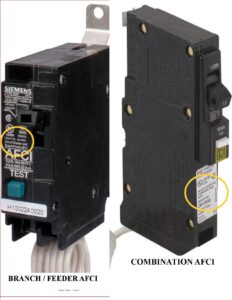ARC Fault Circuit Protection and Home Inspections – PART 1- Service Panel inspection
ARC Fault Circuit Protection and Home Inspections – PART 1- Service Panel inspection
Section 201.12 of the 2014 National Electric Code (NEC) now requires arc fault (AFCI) protection in all areas that do not currently require Ground Fault Circuit Interrupters (GFCI’s). Arc fault’s occur basically when current travels through air. This happens because of loose or incomplete connections, or possibly a screw or nail has penetrated or come in contact with a conductor. Think of a spark plug as one example of an electrical arc. These “arcs” can be several thousands degrees strong, while still drawing less current than is necessary to interrupt the circuit, or “trip” the breaker thus creating a fire hazard. So how should these be inspected? We will look at the only six accepted installation methods for arc fault (AFCI) protection next month. This month we will focus on the service panel and the difference between a Combination AFCI, and a Branch/Feeder type AFCI circuit breaker MORE……
Differences between a Combination and Branch / Feeder AFCI Breaker
It is extremely important to note that a “combination” AFCI circuit breaker does not mean that it provides both AFCI and GFCI protection. Both Branch Feeder and Combination AFCI’s provide conventional thermal and magnetic overcurrent protection. Both provide high current or parallel arcing fault detection and fire protection for branch circuit wiring and connected cords. The Combination AFCI has the added benefit of enhanced detection of persistent low current or series arcing faults which mitigate fire hazards in extension cords connected to receptacles. The circuit breaker will also be labeled – “Combination Type” or “Branch/Feeder” AFCI.
Inspection in the main service panel –
Looking at the pictures at the beginning of the article, you can see that there is a white wire attached to the AFCI circuit breaker. This wire should be connected to the neutral bus in the electric service panel. The hot and neutral branch circuit wires will both be connected to the ARCI breaker. The installation is similar to that of a GFCI circuit breaker. Pressing the test button on the circuit breaker itself or using a AFCI tester in the branch circuit are the best ways to test it. The inspector should make a mental note if the breaker is a combination or branch feeder because they are used for AFCI protection in different combinations. If the wrong type of AFCI breaker is used the circuit may not be properly protected. This will also give us a clue as to whom may have installed the AFCI. For instance if a Combination type AFCI is installed for a branch circuit in the service panel, then no other additional requirements are necessary. However if a Branch/Feeder AFCI breaker is installed for a branch circuit, then an additional AFCI receptacle outlet is required to be installed at the first outlet box. Double pole Combination AFCI circuit breakers are installed the same as outlined above. They should be used for 240 volt circuits and multi-branch circuit wiring. Some manufactures have light indicators on the AFCI circuit breakers that will indicate why and possibly when the AFCI was tripped. For instance if the trip was a result of an arcing fault, an arcing fault to ground, or if it tripped as a result of an overcurrent condition. Any light or trip indicators should be noted.
Related Articles:
- GFCI Inspections
- Inspecting Exterior Electrical Components
- Counterfeit Square D Circuit Breakers
- Electrical Sub-Panels – Why Must the Neutrals & Grounds Be Separated
Want To Learn More? Click HERE to Search Our Full Database Of Home Inspector Newsletters.
[/vc_column_text][/vc_column][/vc_row]




